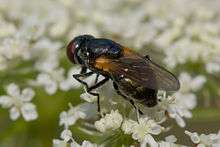Cheilosia impressa
Cheilosia impressa is a Palearctic species of hoverfly. Like most members of its genus C. impressa is a rather small, dark insect and identification can be problematic.[1][2]
| Cheilosia impressa | |
|---|---|
 | |
| female | |
| Scientific classification | |
| Kingdom: | |
| Phylum: | |
| Class: | |
| Order: | |
| Family: | |
| Subfamily: | |
| Tribe: | |
| Genus: | |
| Species: | C. impressa |
| Binomial name | |
| Cheilosia impressa Loew, 1840 | |
Description
External images For terms see Morphology of Diptera
Wing length 5·75–8 mm. A broadly built species. Thorax coarsely punctate, shining, undusted. Legs black Wing base yellow. Coxa 1 with a hornlike projection at the base of the outer side. Facial knob rounded. Part of the impressa species group. The larva is figured by Schmid (1999) [3][4] [5][6]
Biology
Habitat: Deciduous forest, wetland, open areas in deciduous forest, montane, unimproved grassland, grassland up to above 2,000m in the alpine zone, fen. Flowers visited include white Umbelliferae, Compositae. Cirsium, Euphorbia, Filipendula, Geranium, Mentha, Prunus, Ranunculus, Rubus. Flight period is May to July and August to September.[9][10]
References
- Stubbs, Alan E.; Falk, Steven J. (1983). British Hoverflies: An Illustrated Identification Guide. British Entomological & Natural History Society. p. 251, xvpp.
- Van Veen, M.P. (2004). Hoverflies of Northwest Europe, Identification Keys to the Syrphidae (hardback). Utrecht: KNNV Publishing. p. 254. ISBN 90-5011-199-8.
- Schmid, U. (1999) Die Larve von Cheilosia impressa (Diptera: Syrphidae). Volucella 4: 113-119.
- Van der Goot,V.S. (1981) De zweefvliegen van Noordwest - Europa en Europees Rusland, in het bijzonder van de Benelux. KNNV, Uitgave no.32: 275pp. Amsterdam.
- Bei-Bienko, G.Y. & Steyskal, G.C. (1988) Keys to the Insects of the European Part of the USSR, Volume V: Diptera and Siphonaptera, Part I. Amerind Publishing Co., New Delhi. ISBN 81-205-0080-6.
- Coe, R.L. (1953) Diptera: Syrphidae. Handbks.ident.Br.insects, 10(1): 1-98. R.ent.Soc.London. pdf
- Fauna europaea
- Peck, L.V. (1988) Syrphidae. In: Soos, A. & Papp, L. (eds.) Catalogue of Palaearctic Diptera, 8: 11-230. Akad.Kiado, Budapest.
- de Buck, N. (1990) Bloembezoek en bestuivingsecologie van Zweefvliegen (Diptera, Syrphidae) in het bijzonder voor België. Doc.Trav. IRSNB, no.60, 1-167.
- Speight, M.C.D. (2011). "Species accounts of European Syrphidae (Diptera)" (PDF). Syrph the Net, the database of European Syrphidae. 65: 285pp.
| Wikimedia Commons has media related to Cheilosia impressa. |